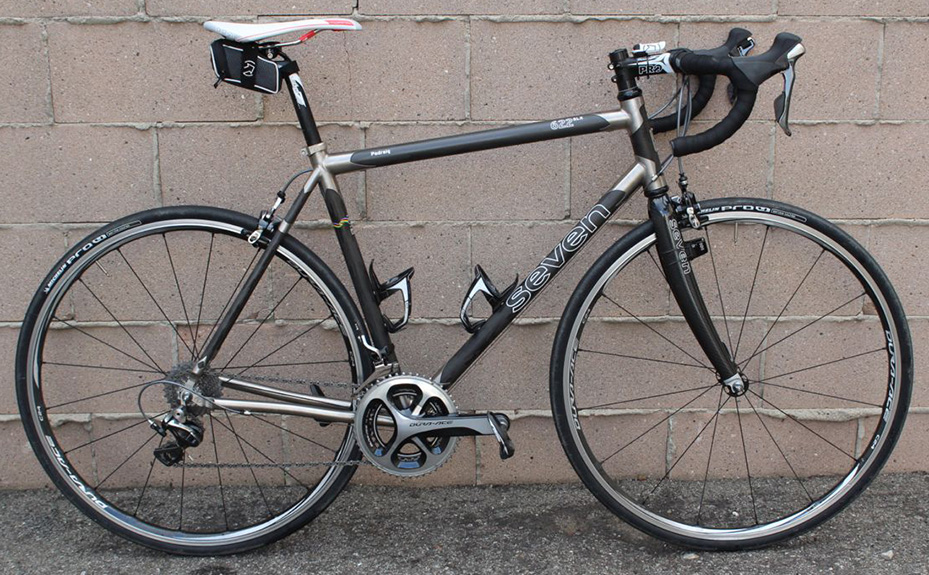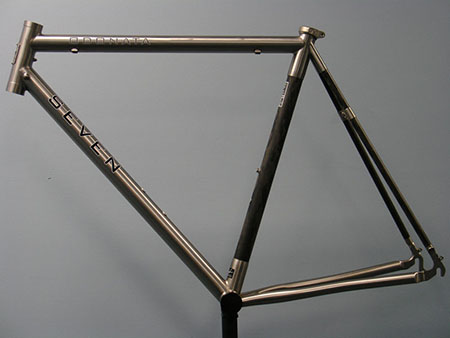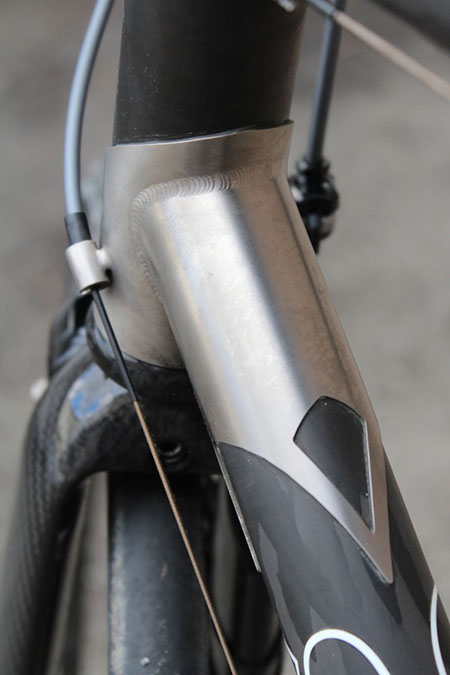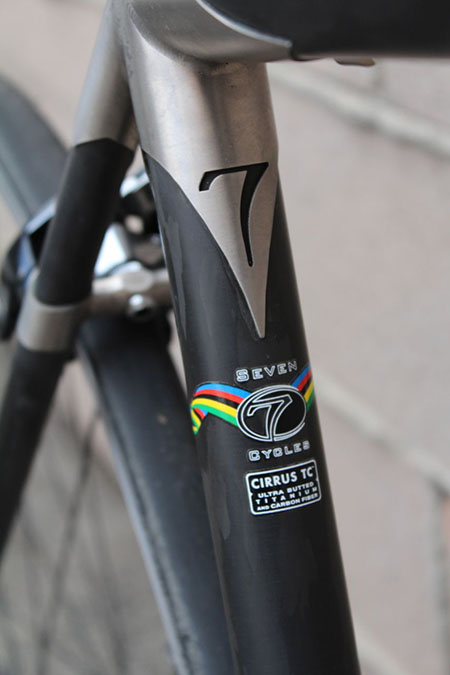

U.S. Built Custom Bicycles in Titanium and Titanium-Carbon Mix
by Padraig

Statement of bias: To the degree that I�m not impartial where Seven Cycles is concerned, I, like many other people, have admired the company since its launch. My affinity goes further than just a Facebook-deep �like.�
I�ve owned an Axiom for about as long as anyone has been able to own one. Mine is C0028. Back in 2010 I had it cut in half and S&S couplers installed to turn it into my travel bike, a purpose for which I�ve used it several times a year since. When I originally reviewed the Axiom I called the bike, �the best I�d ever ridden,� a statement I was able to stand behind for 10 years. They used that quote in marketing materials for nearly as many years and I don�t mind admitting to feeling some pride at seeing the way they put that quote to use.



I�ve wanted to revisit Seven for a review ever since they introduced the Odonata, a bike that changed the course of the industry back in 1997. Before the Odonata, there were no road bikes with titanium, aluminum or steel frames sporting carbon fiber seatstays. The Odonata was the first bike to substitute carbon fiber seatstays (and seat tube) for what would otherwise have been 100-percent titanium construction. Plenty of other bikes had mixed materials. Trek had helped popularize carbon fiber main triangles bonded to an aluminium rear triangle. But Seven turned that formula around, using lively titanium in the main triangle and then positioning carbon fiber in low-stress spots on the bike.
The influence of the Odonata cannot be overstated. It was introduced at the �97 Interbike show and at the �98 Interbike every company who wanted to be seen as contemporary had an aluminium, ti or steel bike (or all three) with a carbon fiber wishbone. That wishbone was a response to the Odonata and companies produced them like McDonald�s makes burgers for the simple fact that it worked. Just how we define �worked� is something I�ll return to later.
Long before Seven ever existed, Merlin Metalworks had done some research to determine which areas of the bicycle flex the least and are subjected to the lowest load under riding forces. Their research led to the RSR, a frame that combined less-robust commercially pure titanium (known to the industry as CP) with the more commonly used 3Al/2.5V���
The Merlin RSR was an attempt by Merlin to offer a less-expensive frame without lowering their standards for welding or alignment. The bike wasn�t a success, at least not in the commercial sense, but it did teach Rob Vandermark a lasting lesson.
My old boss at Bicycle Guide, Garrett Lai, reviewed the RSR and said he�d pick the RSR over any other road bike Merlin produced �based on ride alone.� After joining the staff, I had a chance to put a few miles in on the bike before it was sent back to Cambridge. It was a remarkable bike and unlike other ti bikes I�d ridden up to that point, it made me realize it was possible to make a ti road bike stiff enough to race.
So what the hell does the RSR have to do with the 622 slx? They are kissing cousins. To complete the connection, though, I have to go back to the Seven model called the Elium. The RSR and the Elium are nearly brothers. The Elium replaces the RSR�s CP ti tubes with carbon fiber ones; it features 3/2.5 tubing in the head tube, down tube and chainstays, and carbon fiber in the top tube, seat tube and seat stays. The 622 slx differs from the Elium in that it takes the carbon fiber usage to its logical conclusion. It is a six-carbon-tube frame: top tube, down tube, seat tube, seat stays and head tube. Only the chainstays remain titanium, partly for ride quality, partly for durability in the face of chain slap.It�s worth noting that the Odonata had simple, blunt joints. To the degree that the bike was attractive (and I thought it was gorgeous), its beauty arose from its precision�the stack-of-dimes welds, the gap-free joints, the rich luster of the titanium tubes� surface finish and the nearly iridescent look of the fiber-wound carbon fiber tubes. However, the 622 slx takes a page from its steel forebears by shaping the titanium lugs, giving them points like steel lugs would have. They even cut windows in two of the points to include the brand�s signature numeral 7.
However, I need to note that without the history of point shaping the way a guy like Peter Weigle has, there�s a certain flair that these points lack. Don�t get me wrong, this bike is gorgeous, front to back, but when I see lugs, I�ve been trained to look at the lines of the lugs, to watch how the points curve. The best among them have a certain geometric progression to them, starting shallow and then flairing out as they near the joint; it�s not a line, but a curve. There�s an angularity to the points and windows that doesn�t reflect the look of the most heralded steel lug work. It�s important to keep in mind that lug points weren�t just a triumph of aesthetic; they had a function, too. They were meant to distribute stress over a greater area and the swoopy curves were part of the effort to make sure that stress didn�t collect in some corner, so part of what my eye sees in a beautifully cut lug is artful engineering, defeating stress before it gains a foothold.
Having just written that, I�m aware that people have a right to wonder if I�ve got bowling balls for testes for criticizing the look of a Seven frame, but I know that had those points been shaped by the likes of Peter Weigle, Brian Baylis or Peter Johnson, they wouldn�t take quite that line. My gall notwithstanding, it�s an opportunity to make the frames even prettier. The particular workmanship required to shape said titanium points might be a nightmare, just not my nightmare, though.
Feedback Some years back a mechanical engineer friend of mine told me that if bike companies got smart, they wouldn�t need to use funky elastomers or even suspension to insulate a rider from vibration. He works in aerospace, where a common method of reducing vibration has been to change materials between point A and point B. Think of a seatpost. Imagine that seatpost is 100 percent carbon fiber. Vibrations will move up that post toward the clamp and the saddle. If you transition from carbon fiber to, say, titanium, a great deal of vibration will stop dead at the transition point. I�m simplifying here, but the point is that by mixing materials, you reduce vibration more than you can with a well-made carbon fiber frame. I have to add that modifier �well-made� because while on paper a mixed-materials frame ought to eliminate more vibration than a full carbon frame, my experience is that there are carbon fiber frames out there that are as lifeless as a rubber glove. In those instances, part of the issue is that they don�t offer the same level of stiffness that most of us have come to expect from a top-shelf frame today. While the 622 slx attenuates vibration, I need to be clear that this frame is not lifeless. It�s far from that.
So when I wrote earlier that the Odonata �worked� what I meant was that the amount of vibration at the saddle was less than many similar frames. For most riders, that translated to less lower back fatigue after three, four, five hours.
Even though the 622 slx appears to be an essentially carbon fiber bicycle, it�s very different from most other bikes on the market. The presence of the titanium lugs and chainstays means that a good deal of vibration that would ordinarily reach the rider doesn�t. It would be really easy to deride this bike as old tech. after all, Specialized and Trek both made something very similar to this bike. However, neither of them used carbon fiber tubes that were as stiff, strong and light, so it�s impossible to compare the ride quality. The Treks, of which I rode a few, were only slightly more lively than a cadaver. They were popular because it was a lot of bike for the money, not because they rode like a signal flare on methamphetamine.
Next up, Part II: the ride.